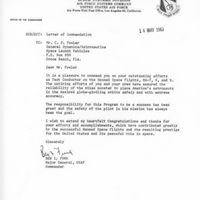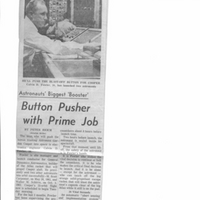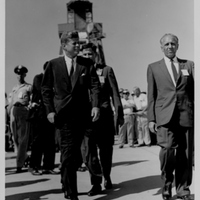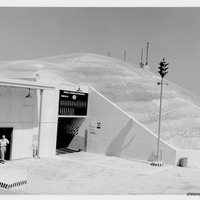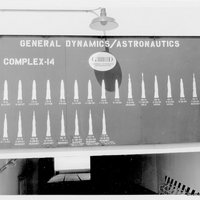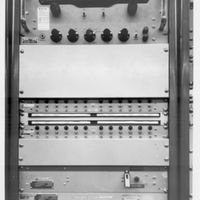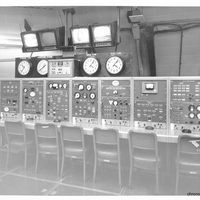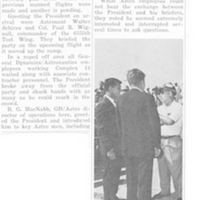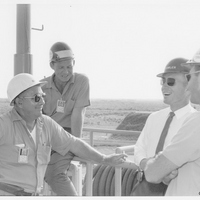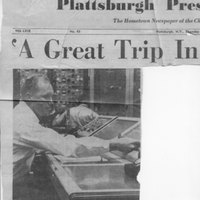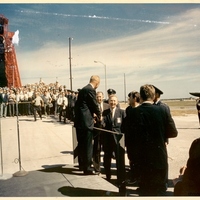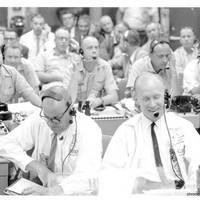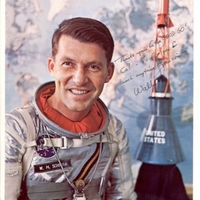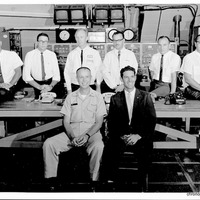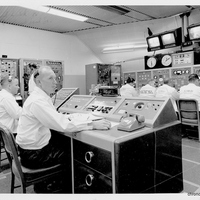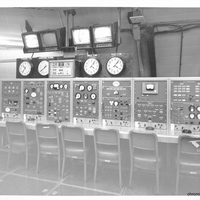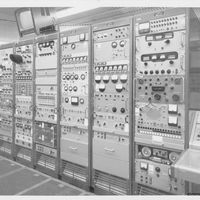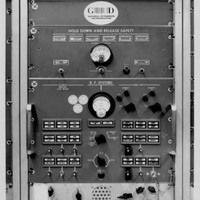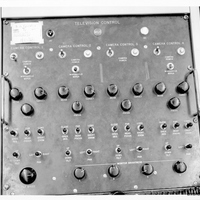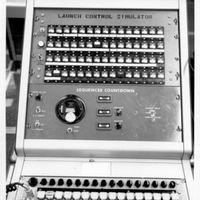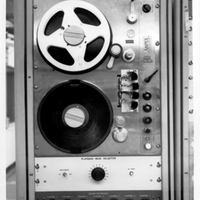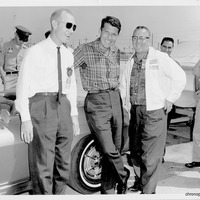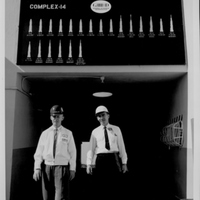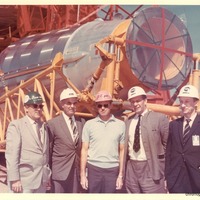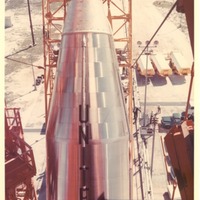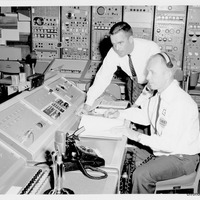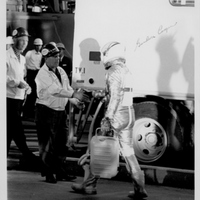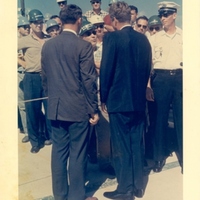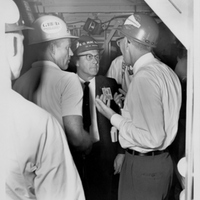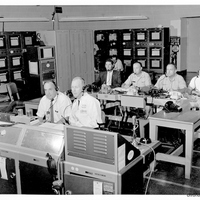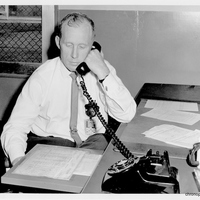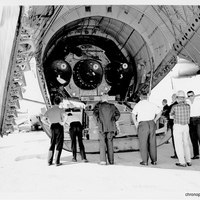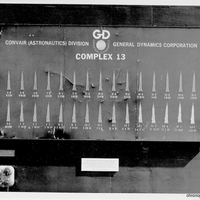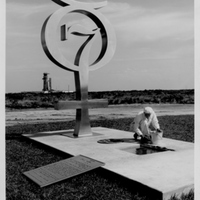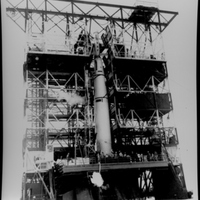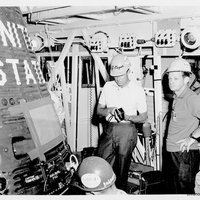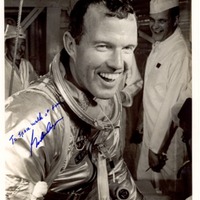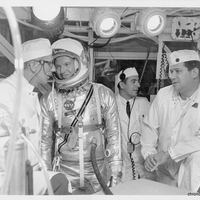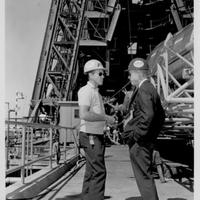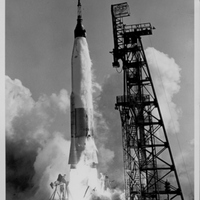Browse Items (40 total)
- Tags: Cape Canaveral AFS
Letter from General Ben I. Funk to Dr. Calvin D. Fowler (May 14, 1963)
Tags: Air Force Systems Command; Air Force Unit Post Office; Atlas; Cal Fowler; Calvin D. Fowler; Cape Canaveral; Cape Canaveral AFS; Cape Canaveral Air Force Station; Cocoa Beach; commendations; El Segundo, California; Funk, Ben Ivan; GDA; General Dynamics/Astronautics; Launch Complex 14; Los Angeles, California; MA-7; MA-8; MA-9; Mercury; Mercury-Atlas; Mercury-Atlas 7; Mercury-Atlas 8; Mercury-Atlas 9; NASA; National Aeronautics and Space Administration; outer space; Project Mercury; space exploration; space programs; Space Systems division; U.S. Air Force; U.S. Air Force Systems Command; USAF
Astronauts' Biggest 'Booster': Button Pusher with Prime Job
Tags: abort sensing and information system; ASIS; astronauts; Atlas; Atlas 130-D; Cal Fowler; Calvin D. Fowler; Cape Canaveral; Cape Canaveral AFS; Cape Canaveral Air Force Station; Cape Canaveral Air Force Station Launch Complex 14; Carpenter, Malcolm Scott; Carpenter, Scott; CCAFS; GDA; General Dynamics/Astronautics; Gordo Cooper; Gordon Cooper; launch; Launch Complex 14; launches; LC-14; Leroy Gordon Cooper, Jr.; Mercury; Mercury-Atlas; NASA; National Aeronautics and Space Administration; outer space; Peter Reich; Project Mercury; Reich, Peter; space exploration; space programs; spacecraft; Wally Schirra; Walter Marty Schirra, Jr.
President John F. Kennedy Touring Cape Canaveral Air Force Station Launch Complex 14
Tags: ; Cape Canaveral; Cape Canaveral AFS; Cape Canaveral Air Force Station; Cape Canaveral Air Force Station Launch Complex 14; Jack Kennedy; JFK; John F. Kennedy; John Fitzgerald Kennedy; Launch Complex 14; LC-14; Mercury; Mercury-Atlas; Mercury-Atlas 5; Mercury-Atlas Five; NASA; National Aeronautics and Space Administration; outer space; Project Mercury; space exploration; space program; space programs
Cape Canaveral Air Force Station Launch Complex 14 Blockhouse
Cape Canaveral Air Force Station Launch Complex 14 Blockhouse Launch Tote Board
Tags: blockhouses; Cape Canaveral; Cape Canaveral AFS; Cape Canaveral Air Force Station; Launch Complex 14; Launch Complex 14 Blockhouse; launch tote boards; LC-14; Mercury; Mercury-Atlas; NASA; National Aeronautics and Space Administration; outer space; Project Mercury; space exploration; space programs
Workstation Containing Analog Electronics in Rack at the Cape Canaveral Air Force Station Launch Complex 14 Blockhouse
Tags: analog electronics; blockhouses; Cape Canaveral; Cape Canaveral AFS; Cape Canaveral Air Force Station; electronic equipment; electronics racks; Launch Complex 14; Launch Complex 14 Blockhouse; LC-14; Mercury; Mercury-Atlas; NASA; National Aeronautics and Space Administration; outer space; Project Mercury; space exploration; space programs
Rocket Monitoring and Launch Workstations at the Cape Canaveral Air Force Station Launch Complex 14 Blockhouse
Tags: analog electronics; blockhouses; Cape Canaveral; Cape Canaveral AFS; Cape Canaveral Air Force Station; electronic equipment; electronics racks; Launch Complex 14; LC-14; Mercury; Mercury-Atlas; Monitoring; NASA; National Aeronautics and Space Administration; outer space; Project Mercury; space exploration; space programs; workstations
GD/Astro Greeters See Kennedy on Cape Trip
Tags: ; 6555th Aerospace Test Group; AMR; astronauts; B. G. MacNabb; Cal Fowler; Calvin D. Fowler; Cape Canaveral; Cape Canaveral AFS; Cape Canaveral Air Force Station; Cape Skid Skip; GDA; General Dynamics/Astronautics; Glenn, John Herschel, Jr.; Jack Kennedy; JFK; John F. Kennedy; John Fitzgerald Kennedy; Launch Complex 14; LC-14; Malcolm Scott Carpenter; Mercury; Mercury-Atlas; NASA; National Aeronautics and Space Administration; outer space; Paul R. Wignall; presidents; Scott Carpenter; Skid Strip; space exploration; space programs; T. J. O'Malley; Thomas Joseph O'Malley; Tom O’Malley; Wally Schirra; Walter Marty Schirra, Jr.
Cal Fowler and Others at the Cape Canaveral Air Force Station Launch Complex 14
Tags: Cal Fowler; Calvin D. Fowler; Cape Canaveral; Cape Canaveral AFS; Cape Canaveral Air Force Station; CCAFS; GDA; General Dynamics/Astronautics; Launch Complex 14; Launch Complex Manager; LC-14; Mercury; Mercury-Atlas; NASA; National Aeronautics and Space Administration; outer space; Project Mercury; space exploration; space programs
A Great Trip in a Sweet Bird
Tags: Air Force; Air Force Space Systems Division; blockhouses; Cal Fowler; Calvin D. Fowler; Cape Canaveral; Cape Canaveral AFS; Cape Canaveral Air Force Station; CCAFS; GDA; General Dynamics/Astronautics; Launch Complex 14; Launch Conductor; LC-14; LC-14 Blockhouse; Mercury; Mercury-Atlas; NASA; National Aeronautics and Space Administration; outer space; Plattsburgh Press-Republican; Project Mercury; Sigma 7; space exploration; space programs; U.S. Air Force; U.S. Air Force Space Systems Division
John Glenn Returning to Cape Canaveral Air Force Station Launch Complex 14 After Mercury 7 Flight
Tags: Anna Margaret Castor; Anna Margaret Glenn; Annie Castor; Annie Glenn; Astronaut Group 1; astronauts; Cape Canaveral; Cape Canaveral AFS; Cape Canaveral Air Force Station; Cocoa Beach; Distinguished Service Medal; Hangar S; Jack Kennedy; JFK; John F. Kennedy; John Fitzgerald Kennedy; John Glenn; John Herschel Glenn, Jr.; Launch Complex 14; LBJ; LC-14; Lyndon B. Johnson; Lyndon Baines Johnson; MA-6; Mercury; Mercury 7; Mercury Control Center; Mercury Seven; Mercury-Atlas; NASA; National Aeronautics and Space Administration; Original Seven; outer space; Patrick AFB; Patrick Air Force Base; presidents; Project Mercury; space exploration; space programs; vice presidents
Dr. Calvin D. Fowler and T. J.O'Malley Observing Project Mercury
Tags: blockhouse; blockhouses; Cal Fowler; Calvin D. Fowler; Cape Canaveral AFS; Cape Canaveral Air Force Station; Faith 7; Gordo; Gordo Cooper; Gordon Cooper; Launch Complex 14; LC-14; Leroy Gordon Cooper, Jr.; MA-9; Mercury; Mercury-Atlas; Mercury-Atlas 9; Mercury-Atlas Nine; Project Mercury; space programs; T. J. O'Malley; Thomas Joseph O'Malley; Tom O’Malley
Astronaut Wally Schirra
Tags: Astronaut Group 1; astronauts; Cal Fowler; Calvin D. Fowler; Cape Canaveral AFS; Cape Canaveral Air Force Station; Launch Complex 14; LC-14; MA-8; Mercury; Mercury 7; Mercury Seven; Mercury-Atlas; Mercury-Atlas 8; NASA; National Aeronautics and Space Administration; Original Seven; outer space; Project Mercury; Sigma 7; space exploration; space programs; Wally Schirra; Walter Marty Schirra, Jr.
Mercury-Atlas Management Team at the Cape Canaveral Air Force Station Launch Complex 14 Blockhouse
Dr. Calvin D. Fowler at the Cape Canaveral Air Force Station Launch Complex 14 Blockhouse's Launch Conductor Console
Tags: blockhouses; Cal Fowler; Calvin D. Fowler; Cape Canaveral; Cape Canaveral AFS; Cape Canaveral Air Force Station; Launch Complex 14; Launch Complex 14 Blockhouse; Launch Conductor; LC-14; Mercury; Mercury-Atlas; NASA; National Aeronautics and Space Administration; outer space; Project Mercury; space exploration; space programs
Launch Control Room at the Cape Canaveral Air Force Station Launch Complex 14 Blockhouse
Tags: blockhouses; Cal Fowler; Calvin D. Fowler; Cape Canaveral; Cape Canaveral AFS; Cape Canaveral Air Force Station; electronic equipment; electronics racks; Launch Complex 14; LC-14; Mercury; Mercury-Atlas; monitors; NASA; National Aeronautics and Space Administration; outer space; Project Mercury; space exploration; space programs; workstations
Electronic Equipment Racks at the Cape Canaveral Air Force Station Launch Complex 14 Blockhouse
Rack of Electronic Equipment at the Cape Canaveral Air Force Station Launch Complex 14 Blockhouse
Television Control Equipment at the Cape Canaveral Air Force Station Launch Complex 14 Blockhouse
Tags: blockhouses; Cape Canaveral; Cape Canaveral AFS; Cape Canaveral Air Force Station; electronic equipment; electronics racks; Launch Complex 14; LC-14; LOX; Mercury; Mercury-Atlas; NASA; National Aeronautics and Space Administration; outer space; Project Mercury; space exploration; space programs; television control
Launch Control Simulator Console at the Cape Canaveral Air Force Station Launch Complex 14 Blockhouse
Tags: blockhouses; Cape Canaveral; Cape Canaveral AFS; Cape Canaveral Air Force Station; electronic equipment; Launch Complex 14; Launch Complex 14 Blockhouse; launch control simulator; LC-14; Mercury; Mercury-Atlas; NASA; National Aeronautics and Space Administration; outer space; Project Mercury; simulation; simulators; space exploration; space programs
Playback Head Selector Equipment at the Cape Canaveral Air Force Station Launch Complex 14 Blockhouse
Tags: Ampex; blockhouses; Cape Canaveral; Cape Canaveral AFS; Cape Canaveral Air Force Station; electronic equipment; electronics racks; Launch Complex 14; Launch Complex 14 Blockhouse; LC-14; Mercury; Mercury-Atlas; NASA; National Aeronautics and Space Administration; outer space; Project Mercury; space exploration; space programs; tape drives; tape recorders
Astronaut Wally Schirra and B. G. MacNabb
Tags: astronauts; B. G. MacNabb; Cape Canaveral; Cape Canaveral AFS; Cape Canaveral Air Force Station; CCAFS; GDA; General Dynamics/Astronautics; Hangar S; Mercury; moat; moats; NASA; National Aeronautics and Space Administration; outer space; Project Mercury; Sigma 7; space exploration; space programs; Wally Schirra; Walter Marty Schirra, Jr.
Dr. Calvin D. Fowler Exiting Cape Canaveral Air Force Station Launch Complex 14 Blockhouse
Tags: blockhouses; Cape Canaveral AFS; Cape Canaveral Air Force Station; Fowler, Cal; Fowler, Calvin "Cal" D.; GDA; General Dynamics/Astronautics; Launch Complex 14; Launch Complex 14 Blockhouse; launch tote board; LC-14; NASA; National Aeronautics and Space Administration; outer space; space exploration; space programs; tote boards
Astronaut Gordon Cooper with Management Team at the Cape Canaveral Air Force Station Launch Complex 14
Tags: Astronaut Group 1; astronauts; Atlas 130D; B. G. MacNabb; Cape Canaveral; Cape Canaveral AFS; Cape Canaveral Air Force Station; CCAFS; Faith 7; GDA; General Dynamics/Astronautics; Gordo Cooper; Gordon Cooper; Launch Complex 14; Launch Pad 14; LC-14; Leroy Gordon Cooper, Jr.; MA-9; Mercury; Mercury 7; Mercury Seven; Mercury-Atlas; Mercury-Atlas 9; NASA; National Aeronautics and Space Administration; Original Seven; outer space; Project Mercury; space exploration; space programs
Atlas Rocket Under Construction at the Cape Canaveral Air Force Station Launch Complex 14
Tags: Astronaut Group 1; Atlas 130D; Cape Canaveral; Cape Canaveral AFS; Cape Canaveral Air Force Station; CCAFS; Faith 7; Launch Complex 14; Launch Pad 14; LC-14; MA-9; Mercury 7; Mercury Seven; Mercury-Atlas; Mercury-Atlas 9; NASA; National Aeronautics and Space Administration; Original Seven; outer space; Project Mercury; space exploration; space programs
Dr. Calvin D. Fowler and Wayne Reid at Launch Conductor's Workstation in Cape Canaveral Air Force Station Launch Complex 14
Tags: Aerospace Corporation; blockhouses; Cal Fowler; Calvin D. Fowler; Cape Canaveral; Cape Canaveral AFS; Cape Canaveral Air Force Station; CCAFS; GDA; General Dynamics/Astronautics; Launch Complex 14; Launch Conductor; LC-14; NASA; National Aeronautics and Space Administration; outer space; space exploration; space programs; Wayne Reid
B. G. MacNabb with Astronaut Gordon Cooper
Tags: Astronaut Group 1; astronauts; B. G. MacNabb; Cape Canaveral; Cape Canaveral AFS; Cape Canaveral Air Force Station; CCAFS; Faith 7; GDA; General Dynamics/Astronautics; Gordo Cooper; Gordon Cooper; Launch Complex 14; Launch Pad 14; LC-14; Leroy Gordon Cooper, Jr.; MA-9; Mercury; Mercury 7; Mercury Seven; Mercury-Atlas; Mercury-Atlas 9; NASA; National Aeronautics and Space Administration; Original Seven; outer space; Project Mercury; space exploration; space programs
President John F. Kennedy with B. G. MacNabb at Cape Canaveral Air Force Station Launch Complex 14
Tags: Astronaut Group 1; B. G. MacNabb; Cape Canaveral; Cape Canaveral AFS; Cape Canaveral Air Force Station; CCAFS; Faith 7; GDA; General Dynamics/Astronautics; Jack Kennedy; JFK; John F. Kennedy; John Fitzgerald Kennedy; Launch Complex 14; Launch Pad 14; LC-14; MA-9; Mercury; Mercury 7; Mercury Seven; Mercury-Atlas; Mercury-Atlas 9; NASA; National Aeronautics and Space Administration; Original Seven; outer space; Project Mercury; space exploration; space programs
Astronaut Gordon Cooper at Cape Canaveral Air Force Station Launch Complex 14 Launchpad
Tags: Astronaut Group 1; astronauts; B. G. MacNabb; Cape Canaveral; Cape Canaveral AFS; Cape Canaveral Air Force Station; CCAFS; Faith 7; GDA; General Dynamics/Astronautics; Gordo Cooper; Gordon Cooper; Guenter Wendt; Günter F. Wendt; Günter Wendt; Launch Complex 14; Launch Pad 14; LC-14; Leroy Gordon Cooper, Jr.; MA-9; McDonnell Aircraft Corporation; Mercury 7; Mercury Seven; Mercury-Atlas; Mercury-Atlas 9; NASA; National Aeronautics and Space Administration; Original Seven; outer space; Project Mercury; space exploration; space program; space programs
Launch Crew in the Cape Canaveral Air Force Station Launch Complex 14 Launchpad Blockhouse
Tags: blockhouse; blockhouses; Cape Canaveral; Cape Canaveral AFS; Cape Canaveral Air Force Station; Cape Canaveral Air Force Station Launch Complex 14; Cape Canaveral Air Force Station Launch Complex 14 Blockhouse; CCAFS; Launch Complex 14; Launch Complex 14 Blockhouse; Launch Complex Manager; Launch Conductor; launch crews; LC-14; Mercury; Mercury-Atlas; NASA; National Aeronautics and Space Administration; outer space; Project Mercury; space exploration; space programs; T. J. O'Malley; Thomas Joseph O'Malley; Tom O’Malley
Dr. Calvin D. Fowler as a Test Conductor at Cape Canaveral Air Force Station Launch Complex 11
Atlas Core Arriving at Cape Canaveral
Tags: Atlas; Cape Canaveral; Cape Canaveral AFS; Cape Canaveral Air Force Station; CCAFS; Convair; Convair/General Dynamics; General Dynamics; Launch Complex 14; LC-14; Mercury; missiles; NASA; National Aeronautics and Space Administration; outer space; Project Mercury; Skid Strip; space exploration; space programs
Cape Canaveral Air Force Station Launch Complex 13 Launch Tote Board
Tags: Atlas; blockhouses; Cape Canaveral; Cape Canaveral AFS; Cape Canaveral Air Force Station; CCAFS; Convair; Convair Astronautics Division; GDA; General Dynamics Corporation; General Dynamics/Astronautics; Launch Complex 13; Launch Complex 13 Blockhouse; launches; LC-13; NASA; National Aeronautics and Space Administration; outer space; space exploration; space programs; tote boards
Time Capsule Placed at Mercury 7 Monument
Tags: Astronaut Group 1; Cape Canaveral; Cape Canaveral AFS; Cape Canaveral Air Force Station; CCAFS; Jack Kennedy; JFK; John F. Kennedy; John Fitzgerald Kennedy; Launch Complex 14; LC-14; Marine Corps; Mercury; Mercury 7; Mercury 7 Monument; Mercury Monument; Mercury Seven; monument; NASA; National Aeronautics and Space Administration; Original Seven; outer space; president; Project Mercury; space; space exploration; space program; space programs; time capsule; U.S. Marine Corps
Thor-Able Mission Being Prepared for Launch at Cape Canaveral Air Force Station Launch Complex 17
Tags: Cape Canaveral; Cape Canaveral AFS; Cape Canaveral Air Force Station; CCAFS; intermediate-range ballistic missiles; IRBM; Launch Complex 17; LC-17; NASA; National Aeronautics and Space Administration; outer space; pre-launch; space exploration; space programs; Thor; Thor-Able; U.S. Air Force; USAF
Astronaut Gordon Cooper and Faith 7 Capsule at Cape Canaveral Air Force Station Launch Complex 14
Tags: Astronaut Group 1; astronauts; Cape Canaveral; Cape Canaveral AFS; Cape Canaveral Air Force Station; Capsules; CCAFS; Faith 7; Gordo Cooper; Gordon Cooper; Launch Complex 14; Launch Pad 14; LC-14; Leroy Gordon Cooper, Jr.; MA-9; Mercury; Mercury 7; Mercury Seven; Mercury-Atlas; Mercury-Atlas 9; NASA; National Aeronautics and Space Administration; Original Seven; outer space; Project Mercury; space exploration; space programs
Astronaut Gordon Cooper Autograph
Tags: Astronaut Group 1; astronauts; Cape Canaveral; Cape Canaveral AFS; Cape Canaveral Air Force Station; CCAFS; Faith 7; Gordo Cooper; Gordon Cooper; Launch Complex 14; Launch Pad 14; LC-14; Leroy Gordon Cooper, Jr.; MA-9; Mercury; Mercury 7; Mercury Seven; Mercury-Atlas; Mercury-Atlas 9; NASA; National Aeronautics and Space Administration; Original Seven; outer space; Project Mercury; space exploration; space programs; Space Walk of Fame Museum; U.S. Space Walk of Fame Museum
Günter F. Wendt and Astronaut Gordon Cooper at Cape Canaveral Air Force Station Launch Complex 14
Tags: astronauts; Cape Canaveral; Cape Canaveral AFS; Cape Canaveral Air Force Station; Gordo Cooper; Gordon Cooper; Guenter Wendt; Günter F. Wendt; Günter Wendt; Launch Complex 14; LC-14, MA-9; Leroy Gordon Cooper, Jr.; McDonnell Aircraft Corporation; Mercury; Mercury 7; Mercury 7, Mercury-Atlas, Project Mercury; Mercury-Atlas; Mercury-Atlas 9; NASA; National Aeronautics and Space Administration; outer space; Project Mercury; space; space exploration; space programs
Astronaut Gordon Cooper and Dr. Calvin D. Fowler at Cape Canaveral Air Force Station Launch Complex 14
Tags: Astronaut Group 1; astronauts; Atlas; Atlas 130D; Cal Fowler; Calvin D. Fowler; Cape Canaveral; Cape Canaveral AFS; Cape Canaveral Air Force Station; CCAFS; Faith 7; Gordo Cooper; Gordon Cooper; Launch Complex 14; Launch Pad 14; LC-14; Leroy Gordon Cooper, Jr.; MA-9; Mercury; Mercury 7; Mercury Seven; Mercury-Atlas; Mercury-Atlas 9; NASA; National Aeronautics and Space Administration; Original Seven; outer space; Project Mercury; space exploration; space programs
Friendship 7 Lift Off at the Launch Pad at Cape Canaveral Air Force Station Launch Complex 14
Tags: Astronaut Group 1; Atlas 109D; Cape Canaveral; Cape Canaveral AFS; Cape Canaveral Air Force Station; CCAFS; Friendship 7; John Glenn; John Herschel Glenn, Jr.; Launch Complex 14; Launch Pad 14; launches; LC-14; MA-6; Mercury 7; Mercury Seven; Mercury-Atlas; Mercury-Atlas 6; NASA; National Aeronautics and Space Administration; Original Seven; outer space; Project Mercury; space exploration; space program; space programs
